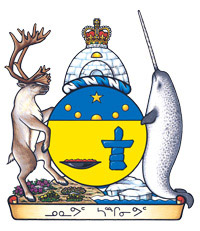The dominant colours, blue and gold, symbolize the riches of the  land, sea and sky.
land, sea and sky.
In the base of the shield, the inuksuk symbolizes the stone monuments which guide the people on the land and mark sacred and other special places. The qulliq, or Inuit stone lamp, represents light and the warmth of family and the community.
Above, the concave arc of five gold circles refers to the life-giving properties of the sun arching above and below the horizon, the unique part of the Nunavut year. The star is the Niqirtsuituq, the North Star and the traditional guide for navigation and more broadly, forever remains unchanged as the leadership of the elders in the community.
In the crest, the igluit (igloo) represents the traditional life of the people and the means of survival. It also symbolizes the assembled members of the Legislature meeting together for the good of Nunavut; with the Royal Crown symbolizing public government for all the people of Nunavut and the equivalent status of Nunavut with other territories and provinces in Canadian Confederation.
The tuktu (caribou) and qilalugaq tugaalik (narwhal) refer to land and sea animals which are part of the rich natural heritage of Nunavut and provide sustenance for people.
The compartment at the base is composed of land and sea and features three important species of Arctic wild flowers.
The motto, in Inuktitut, NUNAVUT SANNGINIVUT means Nunavut, our strength.
The Coat of Arms was designed by Andrew Qappik from Pangnirtung.
The Mace and the Coat of Arms of Nunavut are copyrighted symbols reserved for the official use of the Legislative Assembly of Nunavut, and may not be used without the express permission of the Clerk’s office.
